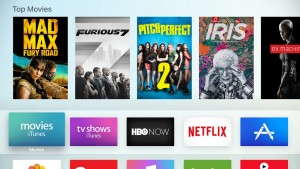Article

Netflix – one of many SVOD providers
Say Goodbye to Video on Demand Browsing Fatigue | LinkedIn Pulse
My Comments
A common situation that will happen is for us to sign up to Netflix as well as using our Apple ID and credit card to purchase or rent video content on iTunes. But we subsequently know of one or more other video-on-demand services that have a content library that appeals to us. This becomes more real as boutique video-on-demand enters the spotlight or newer operators join the video-on-demand scene.

SBS On-Demand – an example of an advertising-funded boutique VOD provider
Here, we end up heading down a path where we have to switch between multiple user interfaces on our smart TV, video peripheral or tablet to find the content we want to watch. In some cases, it could end up with us acquiring extra video peripherals and selecting different sources on our TVs in order to go to different video-on-demand providers, because they don’t appear on the connected-video platform we primarily use.
But what can happen is that we are after a particular title or shows like it and want to know where it is available without spending a lot of time searching for it. This is where content-search-aggregation can come in handy.

Multiple VOD and catch-up TV providers on a smart-TV or set-top box vie for our attention
What is this? It is where you supply the name of a particular piece of video content and the content-search-aggregation engine lists which video-on-demand providers have the content you searched for. It would support the different business models that video-on-demand providers work on such as subscription, transactional and advertising.
It is very similar to the success of TuneIn Radio, vTuner and Radioline in providing an aggregated Internet-radio directory used in Internet radios, both of the “big set” (hi-fi system) and “small set” (table radio, portable) kind; and the Internet-radio apps available on every desktop, mobile or smart-TV platform.
I would like to see these aggregated-content-search engines have, as part of their personalisation efforts, the ability to provide a results view that is based on the services you deal with such as the subscription VODs you subscribe to, the transactional VODs you have registered with and the advertising VODs you regularly visit. In the case of transactional services including “download-to-own” or “download-to-view” storefronts, the results could be sorted by the cost to view in your local currency. But it could be feasible to provide an advertising service on these search engines that list other VOD services carrying the same kind of content in your area, especially boutique providers that run with this content. This can put new streaming or download-driven online-video providers “on the map” as far as the viewership is concerned.
Client-based implementations could work with your downloaded content library along with the streaming and download-based services in order to search through these catalogues for what you are after.
Similarly, these search engines can aid in the content-discovery process by allowing us to find content similar to a specific title or having specific attributes hosted by the providers you deal with. If you are using a VOD service that has an account system for payment or personalisation, it could be feasible for these search engines to “pass” the title to the service so you can put it in your viewing list or favourite-content list, instigate a purchase / rental transaction for that title in the case of a transaction-driven service or immediately have it playing.
To the same extent, the aggregated-content-search platform that links with your accounts on the various VOD services can provide the ability to show an aggregate view of the content recommendations that the services provide based on your past viewing.
Another factor that influences our viewing choices is the content recommended by film critics, radio hosts and other personalities that we follow. Here, some of these personalities or the publishers and broadcasters they work with maintain some form of Web presence, typically through a social-media account, blog or something similar. Here they may use this presence to provide a list of content they recommend or simply cite a particular film or TV series.
But these Web presences cam be made more powerful either through RSS feeds for “recommended-viewing” lists or the ability to link a film’s title to the search engine. These can be facilitated through an express hyperlink to the aggregated-content search engine’s entry for that title. On the other hand, the combination of standardised structured-data-markup and software that interprets this markup and passes this data to these search engines could provide for a competitive approach. In the case of “recommended-viewing” lists delivered as RSS feeds, aggregated-content-search engines could implement a mechanism similar to Web-based newsfeed readers of the Feedly kind for adding these lists.
To the same extent, these personalities could contribute their knowledge about titles to an aggregated-content-search engine to turn it in to a rich video-content portal that helps viewers choose the content they are after.
There are a few of these aggregated-content-search engines existing but these are primarily Web-based or mobile-based services, with Roku offering theirs as part of their set-top-box platform. They currently link with the main video-content resources like IMDB and RottenTomatoes along with the current popular VODs.
But they have to be able to work across multiple platforms including smart-TV / set-top-box platforms, support extensive end-user personalisation along with allowing users to follow content recommendations that their favourite personalities offer. As well, if the concept of “download-to-own” picks up, an aggregated-content-search platform could be used to find content that you have in your collection or could “pick up on” through “download-to-own” storefronts,

VOD content-search aggregation
Article
Netflix – one of many SVOD providers
Say Goodbye to Video on Demand Browsing Fatigue | LinkedIn Pulse
My Comments
A common situation that will happen is for us to sign up to Netflix as well as using our Apple ID and credit card to purchase or rent video content on iTunes. But we subsequently know of one or more other video-on-demand services that have a content library that appeals to us. This becomes more real as boutique video-on-demand enters the spotlight or newer operators join the video-on-demand scene.
SBS On-Demand – an example of an advertising-funded boutique VOD provider
Here, we end up heading down a path where we have to switch between multiple user interfaces on our smart TV, video peripheral or tablet to find the content we want to watch. In some cases, it could end up with us acquiring extra video peripherals and selecting different sources on our TVs in order to go to different video-on-demand providers, because they don’t appear on the connected-video platform we primarily use.
But what can happen is that we are after a particular title or shows like it and want to know where it is available without spending a lot of time searching for it. This is where content-search-aggregation can come in handy.
Multiple VOD and catch-up TV providers on a smart-TV or set-top box vie for our attention
What is this? It is where you supply the name of a particular piece of video content and the content-search-aggregation engine lists which video-on-demand providers have the content you searched for. It would support the different business models that video-on-demand providers work on such as subscription, transactional and advertising.
It is very similar to the success of TuneIn Radio, vTuner and Radioline in providing an aggregated Internet-radio directory used in Internet radios, both of the “big set” (hi-fi system) and “small set” (table radio, portable) kind; and the Internet-radio apps available on every desktop, mobile or smart-TV platform.
I would like to see these aggregated-content-search engines have, as part of their personalisation efforts, the ability to provide a results view that is based on the services you deal with such as the subscription VODs you subscribe to, the transactional VODs you have registered with and the advertising VODs you regularly visit. In the case of transactional services including “download-to-own” or “download-to-view” storefronts, the results could be sorted by the cost to view in your local currency. But it could be feasible to provide an advertising service on these search engines that list other VOD services carrying the same kind of content in your area, especially boutique providers that run with this content. This can put new streaming or download-driven online-video providers “on the map” as far as the viewership is concerned.
Client-based implementations could work with your downloaded content library along with the streaming and download-based services in order to search through these catalogues for what you are after.
Similarly, these search engines can aid in the content-discovery process by allowing us to find content similar to a specific title or having specific attributes hosted by the providers you deal with. If you are using a VOD service that has an account system for payment or personalisation, it could be feasible for these search engines to “pass” the title to the service so you can put it in your viewing list or favourite-content list, instigate a purchase / rental transaction for that title in the case of a transaction-driven service or immediately have it playing.
To the same extent, the aggregated-content-search platform that links with your accounts on the various VOD services can provide the ability to show an aggregate view of the content recommendations that the services provide based on your past viewing.
Another factor that influences our viewing choices is the content recommended by film critics, radio hosts and other personalities that we follow. Here, some of these personalities or the publishers and broadcasters they work with maintain some form of Web presence, typically through a social-media account, blog or something similar. Here they may use this presence to provide a list of content they recommend or simply cite a particular film or TV series.
But these Web presences cam be made more powerful either through RSS feeds for “recommended-viewing” lists or the ability to link a film’s title to the search engine. These can be facilitated through an express hyperlink to the aggregated-content search engine’s entry for that title. On the other hand, the combination of standardised structured-data-markup and software that interprets this markup and passes this data to these search engines could provide for a competitive approach. In the case of “recommended-viewing” lists delivered as RSS feeds, aggregated-content-search engines could implement a mechanism similar to Web-based newsfeed readers of the Feedly kind for adding these lists.
To the same extent, these personalities could contribute their knowledge about titles to an aggregated-content-search engine to turn it in to a rich video-content portal that helps viewers choose the content they are after.
There are a few of these aggregated-content-search engines existing but these are primarily Web-based or mobile-based services, with Roku offering theirs as part of their set-top-box platform. They currently link with the main video-content resources like IMDB and RottenTomatoes along with the current popular VODs.
But they have to be able to work across multiple platforms including smart-TV / set-top-box platforms, support extensive end-user personalisation along with allowing users to follow content recommendations that their favourite personalities offer. As well, if the concept of “download-to-own” picks up, an aggregated-content-search platform could be used to find content that you have in your collection or could “pick up on” through “download-to-own” storefronts,
Related Posts
The UK to mandate security standards for home network routers and smart devices
A Pro-Ject turntable joins the vinyl revival to the home network
Product Review–Sony CMT-MX750Ni Internet-enabled micro music system
About The Author
simonmackay